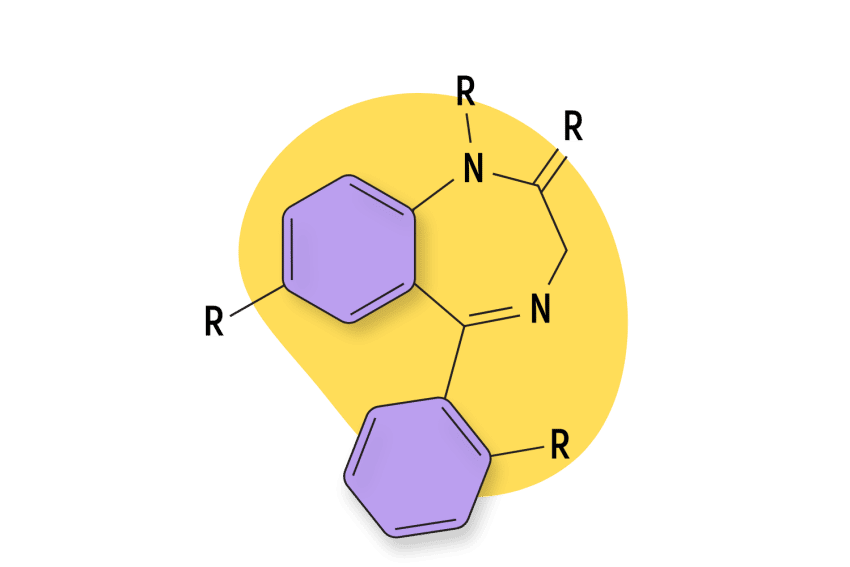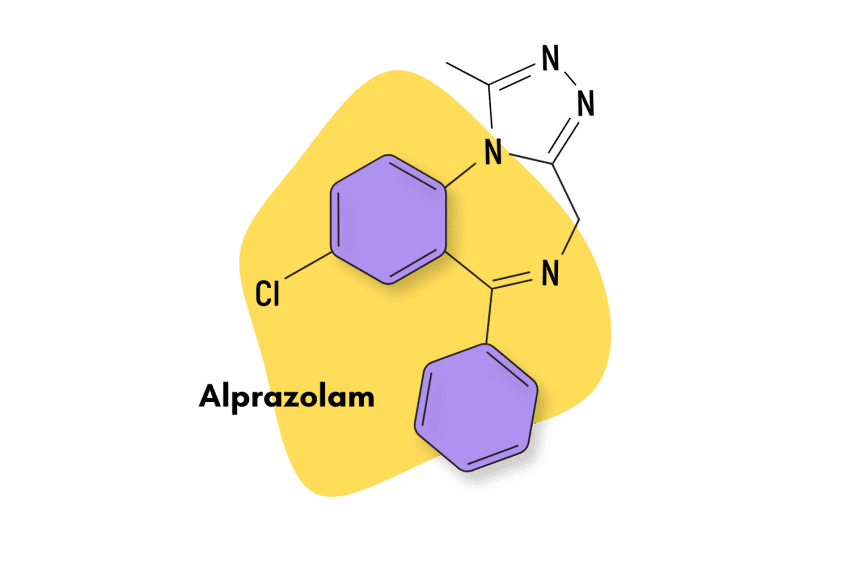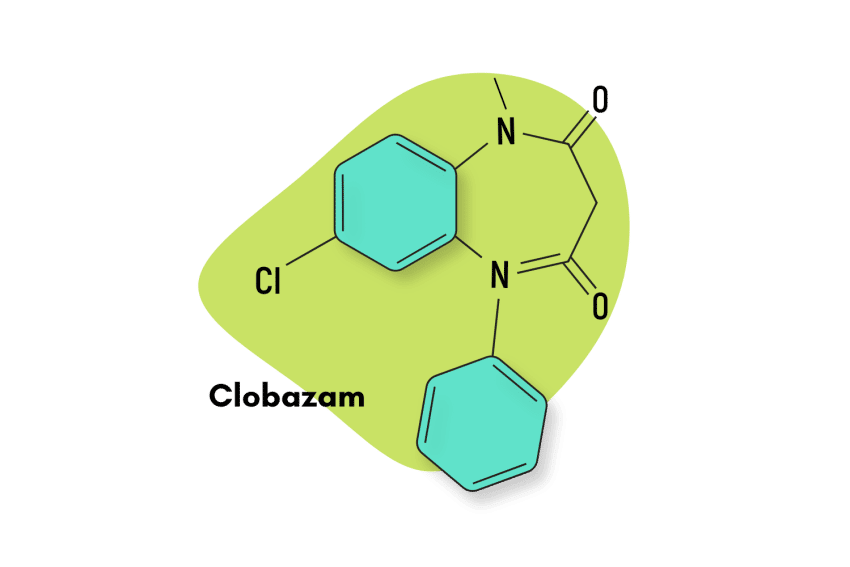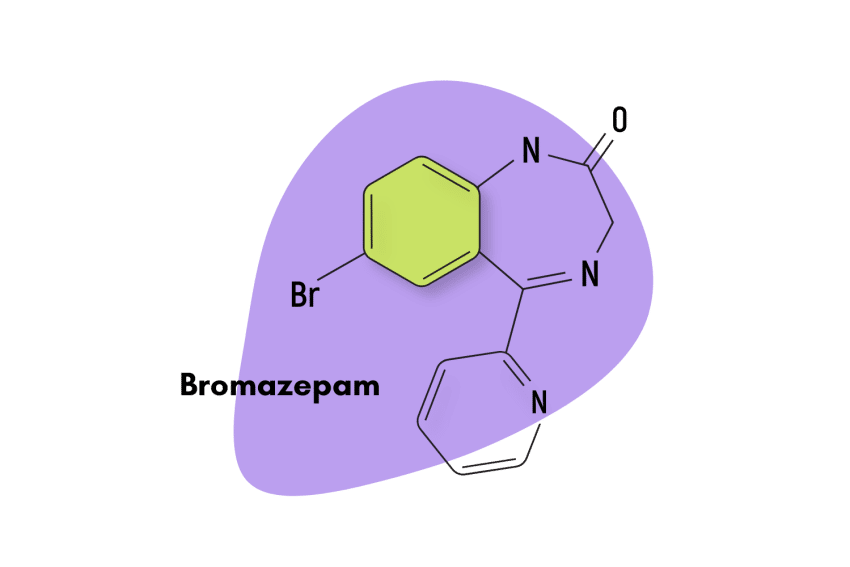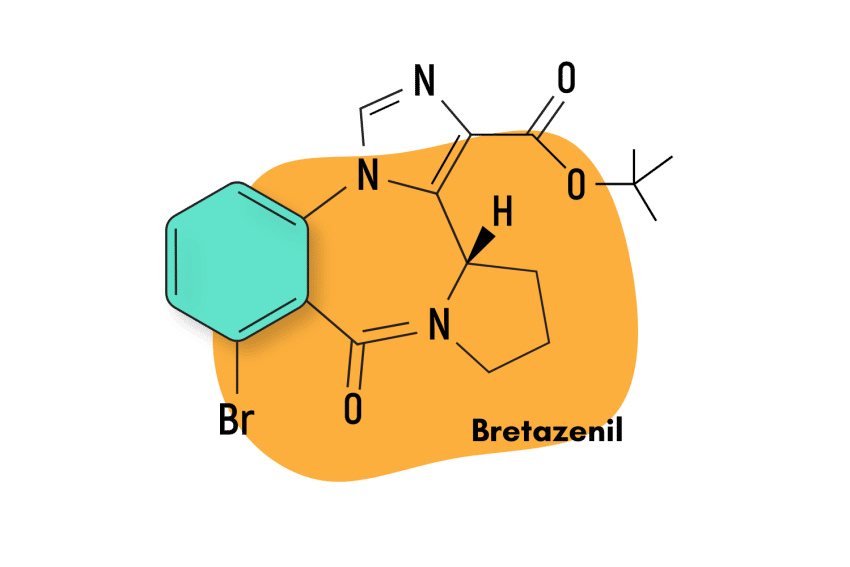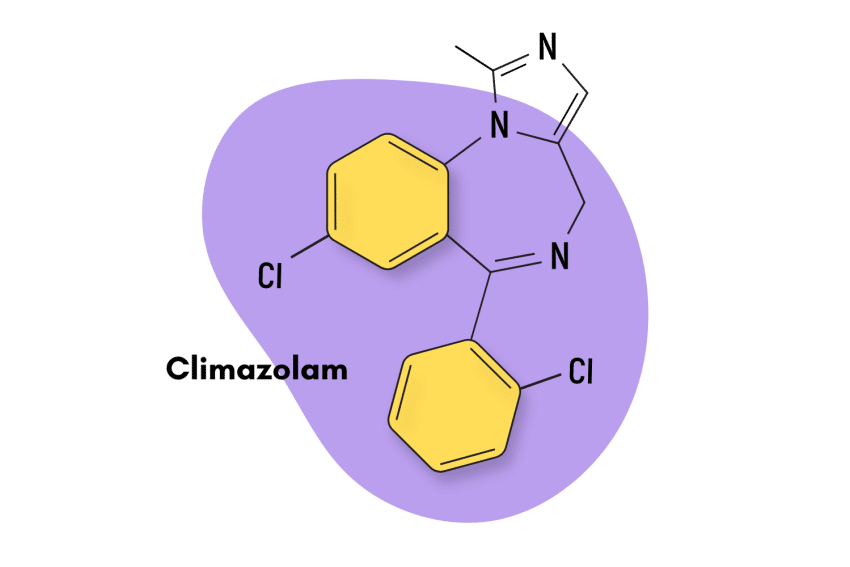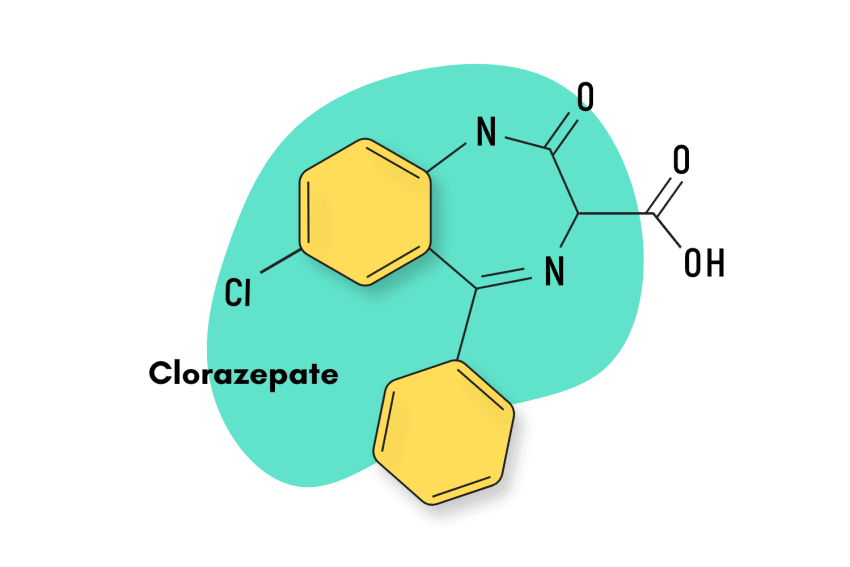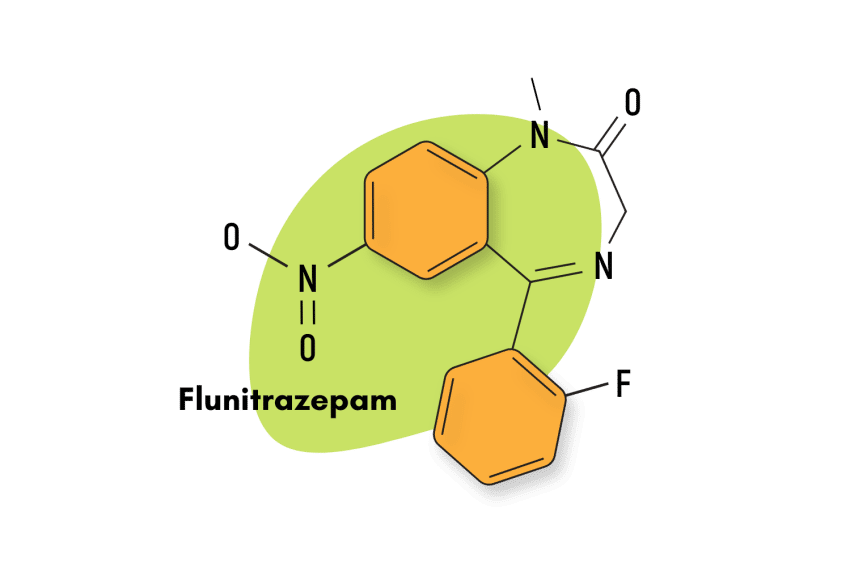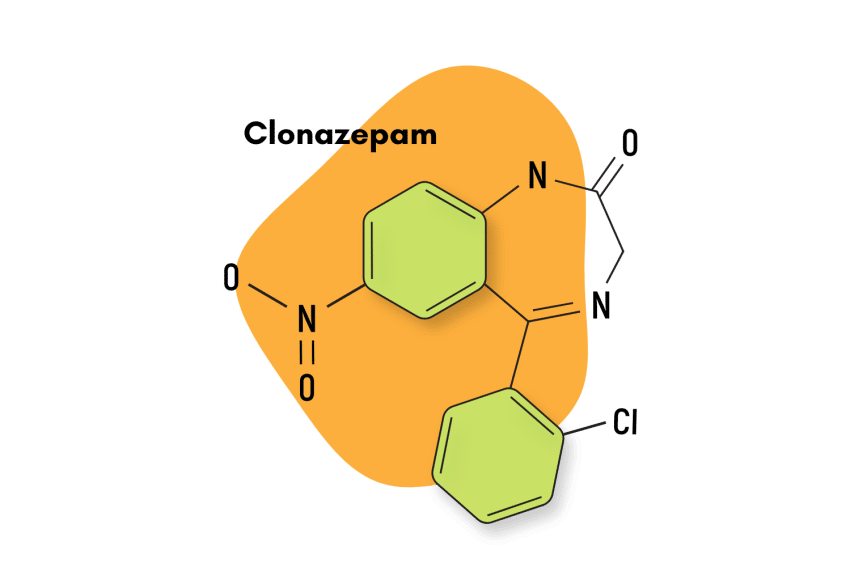Gidazepam: The Next Generation of Antidepressants?
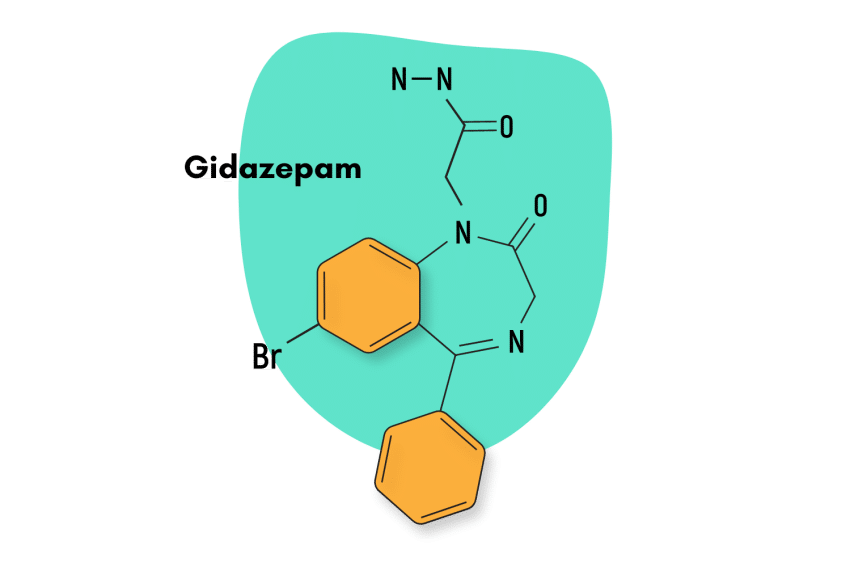
Gidazepam, a benzodiazepine derivative, possesses a unique spectrum of pharmacological activity — it acts as both a conventional anxiolytic benzodiazepine as well an antidepressant.
Unlike other benzodiazepines, gidazepam can also be used as a muscle relaxant, does not have a hypnotic effect, and does not cause fatigue.
Because of its very mild tranquilizing effects compared to other benzodiazepines, gidazepam is often prescribed for daytime use in managing seizure disorders [1].
Gidazepam Specs
| IUPAC Name | 2-(9-bromo-3-oxo-6-phenyl-2,5-diazabicyclo[5.4.0] undeca-5,8,10,12-tetraen-2-yl)acetohydrazide |
| Other Names | Hydazepam, Hidazepam |
| Status | Approved 💊 |
| Common Dosage | 20–50 mg |
| PubChem ID | 121919 |
| CAS# | 129186-29-4 |
Metabolism
Gidazepam is a prodrug that is metabolized to its active form —7-brom-5-phenyl-dihydro-3H-1,4-benzodiazepine. This active metabolite is metabolized to an inactive form by the cytochrome P450 enzymes, including the CYP3A4 enzyme [2].
Duration of Effects
Due to the slow elimination of the active metabolite, the half-life of the drug is around 86 hours. When administered orally, gidazepam is rapidly absorbed. After taking a single dose, the effect of the drug appears in 30 to 60 minutes, reaching a maximum within 1 to 4 hours, followed by a gradual weakening [3].
What Is The Dose Of Gidazepam?
Gidazepam is available in tablet form with doses of 20 mg and 50 mg. The usual dose is 20 to 50 mg, three times a day, and the dose can be gradually increased to 200 mg per day as directed by a doctor [3].
The use of higher daily doses may be accompanied by increased daytime sleepiness and a feeling of muscle weakness. The duration of therapy ranges from several days to 4 months and is determined by the physician individually, depending on the condition and the course of the disease.
Benzodiazepine Dosage Equivalency Calculator
**Caution:** Benzodiazepines have a narrow therapeutic window. Dose equivalents may not be accurate in higher doses.
This calculator does not substitute for clinical experience and is meant to serve only as a reference for determining oral benzodiazepine equivalence.
Please consult a medical practitioner before taking benzodiazepines.
How Does Gidazepam Work?
Gidazepam is metabolized to its active form bromo-nordazepam. The active metabolite binds to the GABA receptor and potentiates the inhibitory effect of gamma-aminobutyric acid (GABA).
Gamma-Aminobutyric acid (GABA) is our major inhibitory neurotransmitter. There are three known GABA receptors — A, B, and C.
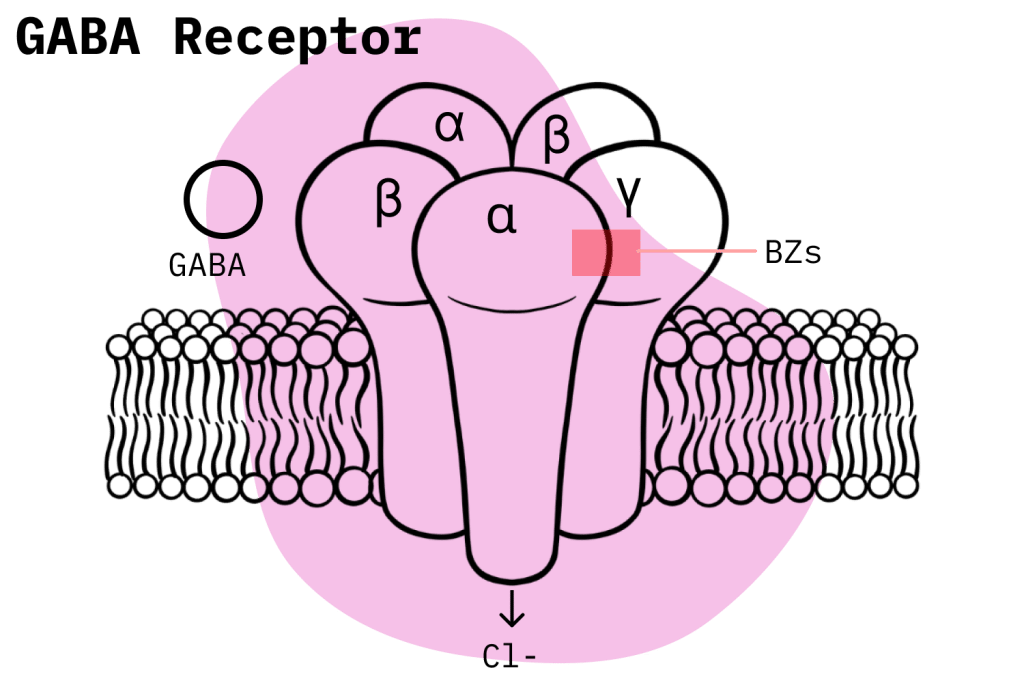
Gidazepa targets GABA-A in particular, which forces a chloride channel to be open — resulting in dramatically reduced excitation of neurons [4].
This activity consequently facilitates various effects like sedation, hypnosis, skeletal muscle relaxation, anticonvulsant activity, and anxiolytic action. This is because such benzodiazepine receptor-associated GABA-A receptors exist both peripherally and in the central nervous system [5].
Is Gidazepam Safe? Risks & Side Effects
Gidazepam is a Schedule IV drug with a high potential for abuse. So, it should be strictly used under the prescription of a doctor. The drug can be habit-forming, and there is a risk of withdrawal after abruptly stopping the drug. Some common symptoms associated with benzodiazepine withdrawal are abdominal cramps, anxiety, sweating, tremors, blurred vision, concentration problems, and dizziness.
The use of gidazepam with other benzodiazepines or sedatives can result in a life-threatening coma and respiratory suppression. However, the sedation caused by gidazepam is less in comparison to other benzodiazepines, and it is generally considered safe to use under the prescription of a doctor.
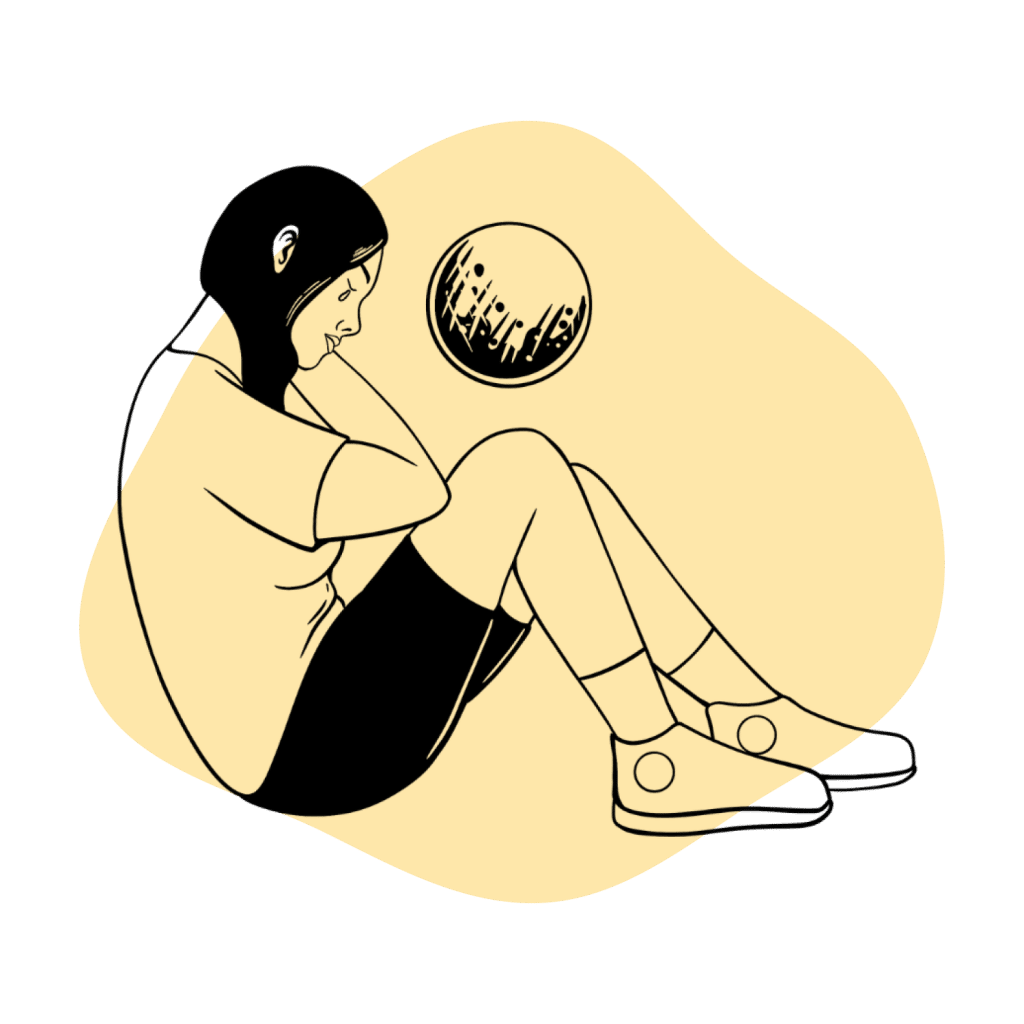
However, there are certain side effects that you might experience despite following all the instructions. The side effects can range from mild to severe.
Common Side Effects of Gidazepam
Mild side effects of gidazepam include:
- Headache
- Drowsiness & lethargy
- Dizziness
- Nausea/vomiting
- Muscle weakness
- Skin rashes/itching
- Allergic reaction
Serious side effects of gidazepam are rare and should be reported to your doctor immediately.
- Reduced respiratory drive results in breathing problems
- Yellowish discoloration of the eyes or skin, known as jaundice, suggests liver problems
- Heart failure with shortness of breath, limb swelling, and fatigue
- Global cognitive problems resulting in memory problems, problems with thinking and attention
- Hallucinations and delusions
- Bleeding problems such as nasal bleeding and gum bleeding
- Depressed mood or suicidal thoughts
- Signs of anaphylaxis such as rashes, itching, hives, swelling of lips, tongue or face, hoarseness of voice, difficulty in breathing, and confusion
Harm Reduction: Gidazepam
Gidazepam has a risk of developing dependence, and there can be withdrawal symptoms associated with it. However, the risk can be reduced by following your doctor’s instructions.
Here are the fundamentals of benzodiazepine harm reduction:
- 🥣 Don’t mix — Mixing benzodiazepines with other depressants (alcohol, GHB, phenibut, barbiturates, opiates) can be fatal.
- ⏳ Take frequent breaks or plan for a short treatment span — Benzodiazepines can form dependence quickly, so it’s important to stop using the drug periodically.
- 🥄 Always stick to the proper dose — The dosage of benzos can vary substantially. Some drugs require 20 or 30 mg; others can be fatal in doses as low as 3 mg.
- 💊 Be aware of contraindications — Benzodiazepines are significantly more dangerous in older people or those with certain medical conditions.
- 🧪 Test your drugs — If ordering benzos from unregistered vendors (online or street vendors), order a benzo test kit to ensure your pills contain what you think they do.
- 💉 Never snort or inject benzos — Not only does this provide no advantage, but it’s also extremely dangerous. Benzos should be taken orally.
- 🌧 Recognize the signs of addiction — Early warning signs are feeling like you’re not “yourself” without the drug or hiding your habits from loved ones.
- ⚖️ Understand the laws where you live — In most parts of the world, benzodiazepines are only considered legal if given a prescription by a medical doctor.
- 📞 Know where to go if you need help — Help is available for benzodiazepine addiction; you just have to ask for it. Look up “addiction hotline” for more information about where you live. (USA: 1-800-662-4357; Canada: 1-866-585-0445; UK: 0300-999-1212).
Similar Benzodiazepine Alternatives
People who take gidazepam tend to like it for the long duration of effects — which can reach up to 2 days in some cases.
There are many other long-acting benzos to consider as well. The most common is chlordiazepoxide (Librium) or diazepam (Valium), but there are plenty of others as well.
Bromazepam isn’t as long-lasting but does offer similar effect profiles to gidazepam.
Alprazolam (Xanax) is much stronger but is one of the shorter-acting benzos available on the market today.
Some people like clonazepam (Klonopin) instead because it exerts a notable euphoric effect on top of the usual calming action.
Gidazepam vs. Other Short To Intermediate-Acting Benzodiazepines [6]
| Gidazepam | Alprazolam | Bromazepam | Diazepam | Chlordiazepoxide | |
| Chemical composition | e2-(7-bromo-2-oxo-5-phenyl-3H-1,4-benzodiazepin-1-yl)acetohydrazide | Benzodiazepine with a triazole ring attached to its structure | 1,4-benzodiazepine | 1,4-benzodiazepine | 1,4-benzodiazepine |
| Route of administration | Oral | Oral | Oral | Oral, IV, IM | Oral, IV |
| Onset of action | 30 to 60 minutes | 30 to 60 minutes | 60 minutes | 15 to 60 minutes | 1 to 2 hours (oral) |
| Peak concentration | 1 to 4 hours | 1 to 2 hours | 1 to 4 hours | 1 to 1.5 hours | 2 hours |
| Duration of effects | Long-acting (20 to 80 hours) | Short-acting (6 to 27 hours) | Intermediate-acting (8 to 9 hours) | Long-acting (20 to 80 hours) | Long-acting (36 to 200 hours) |
| Mechanism of action | GABA-A receptor agonist | GABA-A receptor agonist | GABA-A receptor agonist | GABA-A receptor agonist | GABA-A receptor agonist |
| Medical Uses | PPanic disorders, seizures, anxiety, alcohol withdrawal | Panic disorders, anxiety disorders, insomnia | Anxiety disorder, alcohol withdrawal | Seizures, alcohol withdrawal, insomnia, muscle spasms, panic disorder, anxiety disorders | Panic disorders, alcohol withdrawal, anxiety disorders |
Natural Alternatives To Benzodiazepines
There are certain herbal medications that increase the activity of GABA and function as benzodiazepines. However, there are not enough studies to suggest their recommendation as alternatives to benzodiazepines.
Some natural alternatives to gidazepam are:
1. Kava
Kava, or ‘Piper methysticum,’ is a traditional herbal tea that is considered a non-addictive and non-hypnotic alternative for the treatment of generalized anxiety disorder [7]. It contains kavalactones, which can help manage anxiety, insomnia, and stress as they have similar potentiating action as benzodiazepines on GABA receptors.

2. Gotu Kola
Gotu Kola, or Centella asiatica, is an ancient Chinese, Indonesian, and Ayurvedic herbal medicine that has been used for the treatment of anxiety, epilepsy, depression, and sleep disorders. It’s thought that the therapeutic effects of this herb are due to the potentiating action of GABA within the brain [8].
3. Valerian root
Valerian (Valeriana officinalis L.) is a root used in Europe and Asia as a traditional remedy for sleep disorders. This herb has also been used for the treatment of stress and anxiety.
Studies show valerian root modulates GABA-A receptors and increases the release of GABA in a similar way to benzodiazepine medications [9].

4. GABA Supplements
GABA itself can be supplemented over the counter to help alleviate mild bouts of anxiety or insomnia.
There are various GABA supplements available, but they aren’t as effective at enhancing GABA activity as you might expect. The problem is believed to be the inability of GABA to cross the blood-brain barrier (BBB) [10].
Many natural therapists use GABA alongside other GABAergic herbs to gently enhance their effectiveness but will rarely rely on the use of GABA supplements alone.
5. Passionflower
A study conducted in 2001 compared the efficacy of passionflower extract to that of the benzodiazepine oxazepam [11]. They found that both were equally efficacious in the treatment of generalized anxiety disorder. Furthermore, passionflower was found to be advantageous compared to other benzodiazepines because it produced markedly less sedation and had less of a negative impact on job performance.
Gidazepam FAQs
Here are some of the most frequently asked questions about Gidazepam:
1. What is gidazepam used for?
Gidazepam is useful for multiple psychological conditions, such as anxiety, excessive fear, sleep disorders, as well as emotional lability.
Gidazepam is also used as a general sedative, anti-convulsant, and muscle relaxant.
2. What are the contraindications of gidazepam?
Gidazepam is contraindicated in the following conditions:
- Severe myasthenia gravis
- Liver disease (cirrhosis, infectious disease)
- Chronic kidney disease
- Pregnancy and lactation
- Children under the age of 18
3. Can I drive a car while taking gidazepam?
No, you should not drive a car while taking gidazepam or any other benzodiazepine. Gidazepam reduces reaction time and causes users to become sleepy. Driving under the effects of benzodiazepines is dangerous and should be avoided entirely.
4. Do I need to avoid any foods or drinks while taking gidazepam?
Foods providing stimulating effects, like chocolate, tea, coffee, and carbonated drinks, can reduce the effect of gidazepam and should be avoided.
Likewise, alcohol can potentiate the sedative effects of benzodiazepines and result in an overdose of either the benzodiazepine, alcohol, or both. This can be fatal.
References
- Kolyvanov, G. B., Kruchenkov, A. A., Litvin, A. A., Zherdev, V. P., & Otabekova, S. G. (1993). The pharmacokinetic and biopharmaceutical evaluation of the new tranquilizer gidazepam. Eksperimental’naia i Klinicheskaia Farmakologiia, 56(2), 53-55.
- Zhuk, O. V., Zinkovski, V. G., Golovenko, N. Y., Stankevich, E. A., & Totrova, M. Y. (1999). Biokinetics of gidazepam, derivatives of peptideaminobenzophenones and their metabolites. Experimental and Toxicologic Pathology, 51(4-5), 451-454.
- Zherdev, V. P., Neznamov, G. G., Kolyvanov, G. B., Litvin, A. A., & Otabekova, S. G. (1993). The pharmacokinetic aspects of the clinical action of gidazepam. Eksperimental’naia i Klinicheskaia Farmakologiia, 56(3), 50-52.
- DeVane, C. L., Ware, M. R., & Lydiard, R. B. (1991). Pharmacokinetics, pharmacodynamics, and treatment issues of benzodiazepines: alprazolam, adinazolam, and clonazepam. Psychopharmacology Bulletin, 27(4), 463-473.
- E Nardi, A., Machado, S., Ferreira Almada, L., Paes, F., Cardoso Silva, A., Jose Marques, R., … & Arias-Carrión, O. (2013). Clonazepam for the treatment of panic disorder. Current Drug Targets, 14(3), 353-364.
- National Center for Biotechnology Information (2022). PubChem Compound Summary for CID 121919, Gidazepam. Retrieved September 10, 2022, from https://pubchem.ncbi.nlm.nih.gov/compound/Gidazepam.
- Chua, H. C., Christensen, E. T., Hoestgaard-Jensen, K., Hartiadi, L. Y., Ramzan, I., Jensen, A et al. (2016). Kavain, the major constituent of the anxiolytic kava extract, potentiates GABAA receptors: functional characteristics and molecular mechanism. PLoS One, 11(6), e0157700.
- Gohil, K. J., Patel, J. A., & Gajjar, A. K. (2010). Pharmacological review on Centella asiatica: a potential herbal cure-all. Indian Journal of pharmaceutical sciences, 72(5), 546.
- Shinjyo, N., Waddell, G., & Green, J. (2020). Valerian root in treating sleep problems and associated disorders—A systematic review and meta-analysis. Journal of Evidence-Based Integrative Medicine, 25, 2515690X20967323.
- Boonstra, E., de Kleijn, R., Colzato, L. S., Alkemade, A., Forstmann, B. U., & Nieuwenhuis, S. (2015). Neurotransmitters as food supplements: the effects of GABA on brain and behavior. Frontiers in Psychology, 6, 1520.
- Akhondzadeh, S., Naghavi, H. R., Vazirian, M., Shayeganpour, A., Rashidi, H., & Khani, M. (2001). Passionflower in the treatment of generalized anxiety: A pilot double‐blind randomized controlled trial with oxazepam. Journal of clinical pharmacy and therapeutics, 26(5), 363-367.

